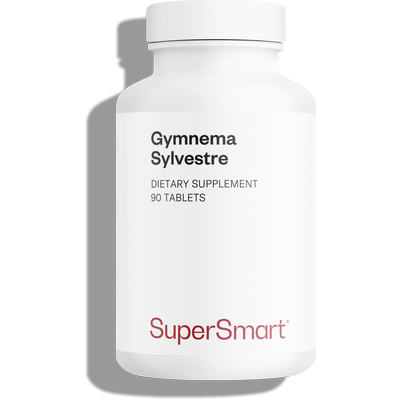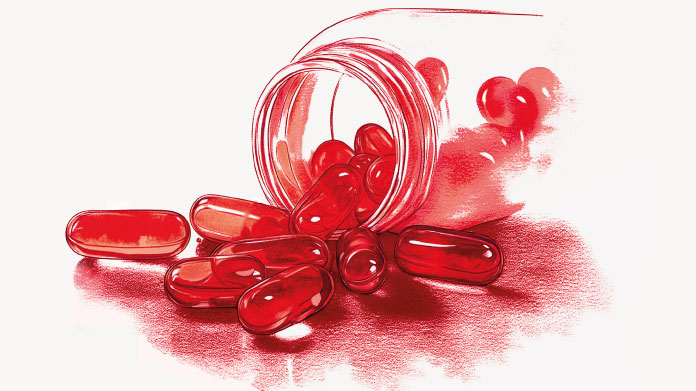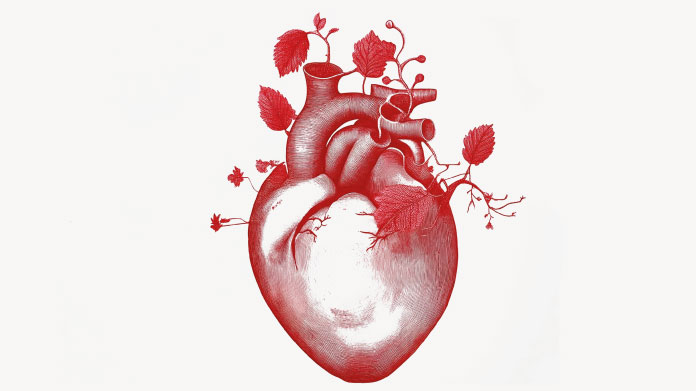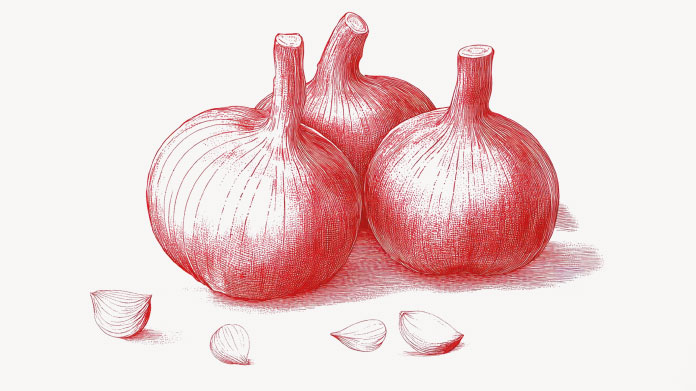Glycaemic load: summary table
Keen to follow a low-glycaemic load diet? This table lists both the glycaemic index and glycaemic load of common foods in alphabetical order
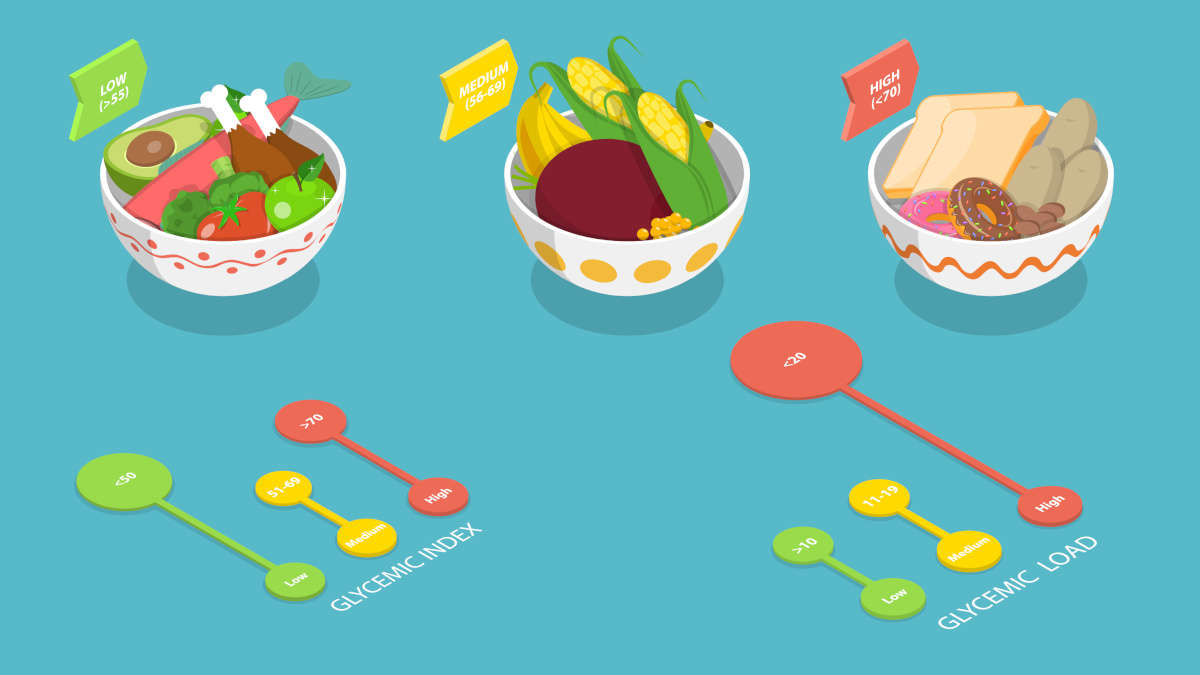
Glycaemic index and glycaemic load
The glycaemic index (GI) is a measure developed by doctors in the 1980s to evaluate the effect of foods on blood sugar levels, as part of efforts to combat diabetes. Basically, the more a food makes blood sugar levels rise, the higher its glycaemic index (1).
This device allowed doctors to understand that not all carbohydrates are necessarily bad for diabetics: some carbohydrates (such as glucose and sucrose) are worse than others (such as fructose and starch).
With this knowledge, they were able to categorise foods according to their GI:
- below 55, a food is classed as low GI ;
- between 55 and 69, it is moderate GI;
- above 70, it is high GI.
However, there are two factors not taken into account by the glycaemic index:
- the amount of carbohydrates a food contains;
- the the serving size normally consumed of that food.
Because of this, we now have the glycaemic load: a new measure which allows a more precise evaluation of a food’s impact on blood sugar(2).
Glycaemic load formula
To determine a food’s glycaemic load, you multiply its glycaemic index by the amount of carbohydrates in an average serving of the food, then divide that by 100.
Let’s take the example of cornflakes:
- they have a GI of 80 ;
- a normal 30g serving contains around 25g of carbohydrates, so their glycaemic load will be (25 x 80)/100 = 20.
What’s an appropriate daily glycaemic load?
It is generally accepted that the daily glycaemic load should be somewhere between 80 and 120. Anything above that is considered too high.
To arrive at this figure, you simply add together the glycaemic load of all the different foods consumed during the day (using the amount actually consumed rather than that ‘normally’ consumed).
Glycaemic index and glycaemic load table
To help you, we’ve put together this table of the glycaemic load and index of 50 common foods. As you’ll see, it’s the freshest, least refined and least processed foods which have the lowest glycaemic load (3).
| Food | Portion | Carbohydrates per serving | Glycemic index | Glycemic load |
| 1. Apricot | 100 g | 11 g | 34 | 3.8 |
| 2. Dried apricot | 100 g | 60 g | 35 | 21 |
| 3. Banana | 100 g | 23 g | 48 | 11 |
| 4. Cooked wheat | 100 g | 62 g | 50 | 32 |
| 5. Bulgur | 100 g | 76 g | 55 | 42 |
| 6. Raw carrot | 200 g | 20 g | 16 | 3.2 |
| 7. Cooked carrot | 200 g | 20 g | 49 | 9.8 |
| 8. Cherry | 100 g | 12 g | 25 | 3 |
| 9. Dark chocolate | 30 g | 6 g | 23 | 1.4 |
| 10. Dates | 30 g | 15 g | 29 | 4 |
| 11. Dried dates | 50 g | 35 g | 40 | 14 |
| 12. Wheat flour T150 (wholemeal bread) | 30 g | 15 g | 70 | 10 |
| 13. Wheat flour T55 (baguette) | 30 g | 18 g | 90 | 16 |
| 14. Wheat flour T65 (country bread) | 30 g | 15 g | 80 | 12 |
| 15. Strawberry | 100 g | 7.7 g | 25 | 1.9 |
| 16. Gnocchi | 200 g | 40 g | 70 | 28 |
| 17. Cooked white beans | 200 g | 30 g | 40 | 12 |
| 18. Cooked red beans | 200 g | 24 g | 33 | 8 |
| 19. Green beans | 300 g | 12 g | 30 | 3.6 |
| 20. Kiwi | 100 g | 15 g | 50 | 7.5 |
| 21. Cooked lentils | 300 g | 36 g | 30 | 11 |
| 22. Lychee | 100 g | 15 g | 50 | 7.6 |
| 23. Mango | 100 g | 15 g | 53 | 3 |
| 24. Honey | 8 g | 5 g | 53 | 3 |
| 25. Plain muesli | 100 g | 57 g | 40 | 23 |
| 26. Nectarine | 100 g | 12 g | 35 | 4 |
| 27. Nuts | 50 g | 7 g | 15 | 1 |
| 28. Orange | 100 g | 12 g | 35 | 4 |
| 29. Orange juice | 150 mL | 15 g | 45 | 6.75 |
| 30. Grapefruit | 100 g | 11 g | 22 | 2.5 |
| 31. Watermelon | 100 g | 7.5 g | 75 | 5.5 |
| 32. Cooked sweet potato | 200 g | 28 g | 65 | 18.2 |
| 33. Cooked white pasta | 150 g | 40 g | 60 | 24 |
| 34. Cooked wholemeal pasta | 150 g | 40 g | 50 | 20 |
| 35. Fishing | 100 g | 11 g | 35 | 4 |
| 36. Cooked peas | 200 g | 20 g | 50 | 10 |
| 37. Pear | 100 g | 15.5 g | 30 | 4.5 |
| 38. Cooked split peas | 200 g | 28 g | 22 | 6 |
| 39. Apple | 100 g | 14 g | 36 | 5 |
| 40. Apple juice | 100 mL | 11 g | 41 | 4.5 |
| 41. Cooked potato | 200 g | 35 g | 70 | 24.5 |
| 42. Cooked pumpkin | 100 g | 7 g | 65 | 4.5 |
| 43. Plum | 100 g | 11 g | 35 | 4 |
| 44. Cooked quinoa | 200 g | 38 g | 35 | 13 |
| 45. White grape | 100 g | 17 g | 56 | 9.6 |
| 46. White rice | 200 g | 60 g | 70 | 42 |
| 47. Brown rice | 200 g | 60 g | 50 | 30 |
| 48. Buckwheat | 200 g | 60 g | 40 | 24 |
| 49. Semolina | 200 g | 70 g | 60 | 42 |
| 50. Tomato juice | 100 mL | 4.2 g | 35 | 1.5 |
Controlling your blood sugar
If you want to control your weight or indeed lose weight, it’s essential to monitor your blood sugar levels: the metabolism of glucose is a factor in weight gain, and especially fat mass gain.
This is because foods with a high glycaemic load produce a spike in insulin, and insulin allows glucose to enter cells. Any excess glucose generated is then metabolised into fat cells called adipocytes.
The good news is there are several plants and natural remedies that can help to normalise the metabolism of sugars and thus regulate glycaemia. The main ones are:
- banaba, a tropical shrub containing corosolic acid, a pentacyclic triterpene which transports glucose across the cell membrane (4-5) ;
- barberry, a semi-tropical shrub containing berberine, an alkaloid which promotes glucose metabolism and helps maintain normal glycaemia (6) ;
- Gymnema sylvestris, an Ayurvedic plant containing gymnemic acid, which is believed to delay the absorption of glucose into the blood, thus helping to normalise sugar metabolism (7-8).
SUPERSMART ADVICE
References
- WOLEVER, T. M. The glycemic index. World review of nutrition and dietetics, 1990, vol. 62, p. 120-185.
- VENN, B. J. et GREEN, T. J. Glycemic index and glycemic load: measurement issues and their effect on diet–disease relationships. European journal of clinical nutrition, 2007, vol. 61, no 1, p. S122-S131.
- FOSTER-POWELL, Kaye, HOLT, Susanna HA, et BRAND-MILLER, Janette C. International table of glycemic index and glycemic load values: 2002. The American journal of clinical nutrition, 2002, vol. 76, no 1, p. 5-56.
- STOHS, Sidney J., MILLER, Howard, et KAATS, Gilbert R. A review of the efficacy and safety of banaba (Lagerstroemia speciosa L.) and corosolic acid. Phytotherapy Research, 2012, vol. 26, no 3, p. 317-324.
- STOHS, Sidney J., MILLER, Howard, et KAATS, Gilbert R. A review of the efficacy and safety of banaba (Lagerstroemia speciosa L.) and corosolic acid. Phytotherapy Research, 2012, vol. 26, no 3, p. 317-324.
- LI, Cheng, HE, Jin-Zhi, ZHOU, Xue-Dong, et al.Berberine regulates type 2 diabetes mellitus related with insulin resistance. Zhongguo Zhong yao za zhi= Zhongguo zhongyao zazhi= China journal of Chinese materia medica, 2017, vol. 42, no 12, p. 2254-2260.
- SHANMUGASUNDARAM, E. R. B., RAJESWARI, G., BASKARAN, K., et al.Use of Gymnema sylvestre leaf extract in the control of blood glucose in insulin-dependent diabetes mellitus. Journal of ethnopharmacology, 1990, vol. 30, no 3, p. 281-294.
- SANEJA, Ankit, SHARMA, Chetan, ANEJA, K. R., et al.Gymnema sylvestre (Gurmar): A review. Der Pharmacia Lettre, 2010, vol. 2, no 1, p. 275-284.
Keywords
2 Days
The products I use are excel·lent
The products I use are excel·lent
ROSAS Josep Maria
10 Days
Delivery is prompt and I never saw a…
Delivery is prompt and I never saw a quality problem with the manufacturing. It is not possible to assess efficacy on a personal basis, since too many factors come into play. Efficacy can only be assessed statistically with a sufficient number of cases.
Roger De Backer
11 Days
I collaborates with the Supersmart…
I collaborates with the Supersmart more than 10 years. Every thing is going good. Quality of the things is good. Delivery comes in time. Five stars definitely !!!
Oleksiy
11 Days
All good
Simple, frictionless site, easy ordering, good delivery updates and execution.
Chris Robbins
13 Days
I feel better
I feel better
Peter Ammann
14 Days
Prompt delivery
Prompt delivery
JAKUB Radisch
15 Days
My new go-to for top quality supplements!
I am buying more and more of my supplements from this superb, high quality company. Cannot recommend it enough. Plus, excellent customer service with a quick, helpful team and speedy deliveries. Highly recommend Supersmart!
Cecilie H.
18 Days
SUPERSMART WHAT ELSE👍
SUPERSMART WHAT ELSE👍
DIEDERLE Christophe
21 Days
Excellent quality products with…
Excellent quality products with innovative formulas, as someone who has been suffering with acid reflux, these supplements have been lifesavers.
Oriana Moniz
22 Days
high quality supplement!
high quality supplement!
GALANT
22 Days
Good service prompt delivery
Good service prompt delivery
Mrs Marcella Reeves
27 Days
I like your clear explanation
I like your clear explanation. And how to make a choice of products for a specific health problem
Ingrid
33 Days
Great product and it arrives quickly.
Great product and it arrives quickly.
SOMMARIVA Gianni
35 Days
Excellent products and fast service.
Excellent products and fast service. What do we need more?
Margarida
39 Days
The variety of products is amazing
The variety of products is amazing, the offers are good and the sending is very fast. I just miss having a bit more of guidance about combinations, possible interactions, etc.
Maria Angeles Verdu

